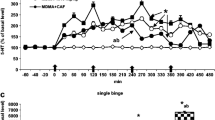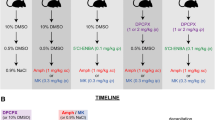Abstract
Caffeine (10–40 mg/kg, p.o.) enhanced locomotor activity (LA). Administration of GABA antagonist, bicuculline (0.5–1.0 mg/kg, i.p.), potentiated this caffeine-induced increase of LA, as well as LA of control rats. Treatment with the GABA agonist, muscimol (0.25–1 mg/kg, i.p.) or dopaminergic antagonist, haloperidol (0.25–1 mg/kg, i.p.) or muscarinic receptor blocker, atropine (3.75–5 mg/kg, i.p.), or inhibitor of acetylcholine esterase physostigmine (0.05–0.30 mg/kg, i.p.) or nicotine (0.5–1.5 mg/kg, i.p.) an nicotinic receptor agonist all decreased the LA of both caffeinetreated and control rats. Haloperidol-induced reduction in caffeine-induced increase in LA was found to be withdrawn with higher dose of caffeine. The dopamine agonist L-Dopa (75–150 mg/kg, p.o.) along with carbidopa (10 mg/kg, p.o.) increased the LA in control rats and potentiated the LA of caffeine treated rats. The haloperidol attenuated the bicuculline-induced increase in LA and atropine or physostigmine attenuated the bicuculline or L-Dopa+carbidopa-induced increase in LA in both caffeine treated and control rats when those drugs were administered concomitantly with bicuculline or L-Dopa+carbidopa. These results suggest that (a) the GABAergic system has direct role in the regulation of LA, and (b) caffeine potentiates LA by antagonism of the adenosine receptor and activation of the dopaminergic system which, in turn, reduces GABAergic activity through the reduction of cholinergic system.
Similar content being viewed by others
References
Nehlig, A., Daval, J. L., and Debry, G. 1992. Caffeine and the central nervous system: mechanism of action, biochemical, metabolic and psychostimulant effects. Brain Res. Review. 17:139–170.
Ray, S. K., and Poddar, M. K. 1990. Role of central serotonin in caffeine-induced stimulation of locomotor activity. Biogenic Amine 7:153–159.
Ukena, D., Shamim, M. T., Padgett, W. L., and Daly, J. W. 1986. Analog of caffeine: Antagonists with selectivity for A2 adenosine receptor. Life Sci. 39:743–750.
Snyder, S. H., Katims, J. J., Annau, Z., Burns, R. F., and Daly, J. W. 1981. Adenosine receptor and behavioral action of methylxanthine. Proc. Natl. Acad. Sci. USA 78:3260–3264.
Choi, O. H., Shamim, M. T., Padgett, W. L., and Daly, J. W. 1988. Caffeine and theophylline analogues correlation of behavioral effects with activity as adenosine receptor antagonist. Life Scii. 43:387–398.
Fredhelm, B. B. 1985. On the mechanism of action of theophylline and caffeine. Acta Med. Scand. 217:149–153.
Mathew, R. J., and Wilson, W. H. 1985. Caffeine-induced changes in cerebral circulation. Stroke. 16:814–817.
Ladinsky, H., Cosolus, S., Banchi, S., and John, A. 1976. Increase in strial acetylcholine by picrotoxin in the rat: Evidence for a GABAergic dopaminergic cholinergic link. Brain Res. 108:351–358.
Sterem, J. R. 1977. Limbic striatum experimental activation of mesolimbic dopaminergic pathway. Int. J. Neurol. 12:30–41.
Nakahiro, M., Fujita, N., Fukuchi, I., Saito, K., Nishimor, G. T., and Yoshida, H. 1985. Pantoyl-gama-aminobutyric and facilitates cholinergic function in the central neurons system. J. Pharmacol. Exp. Therp. 232:501–506.
Chakrabarti, S., Ganguli, A., and Poddar, M. K. 1988. Possible involvement of the GABAergic system in dopaminergic-cholinergic interaction in electroacupuncture-induced analgesia. Meth. Find. Expt. Clin. Pharmacol. 10:545–549.
Biswas, S., and Poddar, M. K. 1990. Dose GABA act through dopaminergic/cholinergic interaction in the regulation of higher environmental temperature-induced change in body temperature. Meth. Find Expt. Clin. Pharmacol. 12:303–307.
Benowitz, N. L. 1990. Clinical pharmacology of caffeine. In Annual Review of Medicine. Creger (eds), 41:277–288.
Dunwiddie, T. V. 1985. The physiological roles of adenosine in central nervous system. Int. Rev. Neurobiol. 27:63–139.
Phillis, J. W., and Wu, P. H. 1981. The role of adenosine and its nucleotides in central synaptic transmission. Prog. Neurobiol. 16: 187–193.
Stone, T. W. 1981. Physiological roles for adenosine and adenosine 5′ triphosphate in the nervous system. Neuroscience 6:523–545.
Mukhopadhyay, S., Ray, S. K. and Poddar, M. K. 1984. Environmental temperature-induced changes in synaptosomal membrane bound enzymes in brain region and locomotor activity. IRCS Med. Sci. 12:283–284.
Keenan, A. and Johnson, F. N. 1972. Development of behavioral tolerance to nicotine in the rat. Experentia 28:428–429.
Tukey, J. W. 1949. Composing individual means in the analysis of variance. Biometrics 5:99–114.
Poddar, M. K. and Mukhopadhyay, S. 1994. GABAergic activity in caffeine-induced tolerant and non-tolerant mammals. (Abstract) 16th International Union of Biochemistry and Molecular Biology Congress (IUBMBC). Vol. II, p. 373.
Kaplan, G. B., Greenblatt, D. J., Ledue, B. W., Thompson, M. L. and Shadder, R. I. 1989. Relationship of plasma and brain concentrations of caffeine and metabolites to benzodiazepine receptor binding and locomotor activity. J. Pharmacol. Exp. Therp. 248: 1078–1083.
Taylor, P. 1990. Cholinergic agonist Chap. 5.in Goodman and Gilman, A., Rall, T. W., Wies, S., Taylor, P. (eds.) Pergamon Press 8th Edition, pp. 122–130.
Author information
Authors and Affiliations
Rights and permissions
About this article
Cite this article
Mukhopadhyay, S., Poddar, M.K. Caffeine-induced locomotor activity: Possible involvement of GABAergic-dopaminergic-adenosinergic interaction. Neurochem Res 20, 39–44 (1995). https://doi.org/10.1007/BF00995150
Accepted:
Issue Date:
DOI: https://doi.org/10.1007/BF00995150




